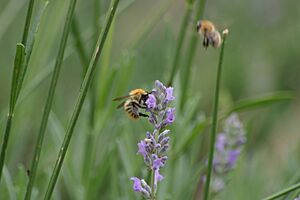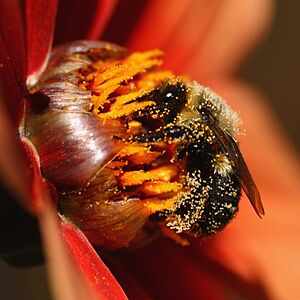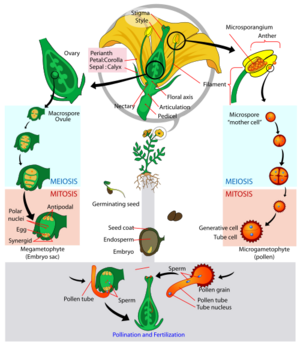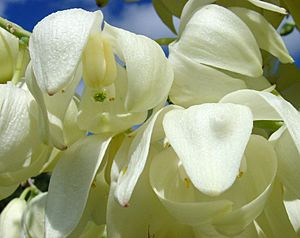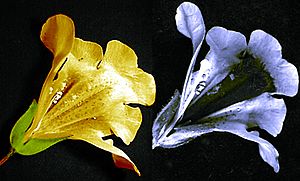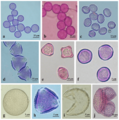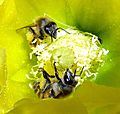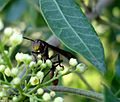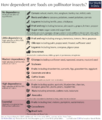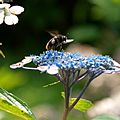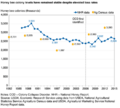Pollination facts for kids
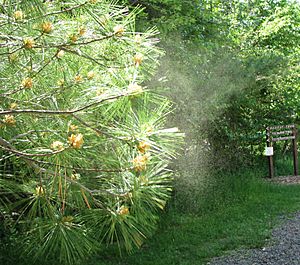

Pollination is a super important part of how plants make new plants. It's like the first step in plant sexual reproduction. It's all about how tiny pollen grains, which carry the male parts of a plant, get to the female parts.
Think of it like this: each pollen grain has half the DNA (genetic information) needed to make a new plant. When it meets the egg in the female part, their DNA combines. This creates a new cell called a zygote, which then grows into a seed. This seed can then grow into a brand new plant!
Contents
How Plants Get Pollinated
Plants use different ways to move their pollen around. Some rely on non-living things like wind or water. Others get help from living creatures like insects or birds.
Wind Pollination: The Corn Story
Have you ever seen a corn field? Maize (also called corn) is a plant that uses the wind for pollination. The male parts of the corn plant release their pollen, and the wind simply blows it over to a nearby female flower on another corn plant.
Corn flowers have changed over time to be good at wind pollination. They don't need bright, pretty petals. Their pollen is very light, so it can easily float in the air. The female parts of the flower are fluffy, like tiny brushes, to catch all those tiny pollen grains as they fly by.
Animal Pollination: Bees and Tomatoes
Now, let's talk about tomato plants. They get help from bees! Bees move pollen from the male parts of one tomato flower to the female parts of another. How? As a bee flies from flower to flower, it collects sweet nectar (a sugary liquid) that the flowers make.
While collecting nectar, pollen sticks to the bee's hairy body. The bees take some nectar and pollen back to their hive for food. But as they visit more flowers, some of that pollen rubs off onto the sticky female parts of other tomato flowers. This helps the tomato plants make new seeds and grow more tomatoes!
Tomato flowers have also changed to attract bees. They often have spread-out petals and look white to us. Bees can see special colors, like ultraviolet light, that we can't. The pollen often sticks together in small clumps, which easily attach to the bee's tiny hairs. Bees even have special "pollen baskets" on their legs to carry pollen back home!
Did you know? About 90% of all flowering plants are pollinated by animals! Only a small number, about 10%, use non-living things like wind or water. And of those, most use wind, with only a tiny bit using water.
What Happens After Pollination
After a pollen grain lands on the right part of a flower, it starts to grow a tiny tube. This is called a pollen tube. This tube grows down into the plant's ovary, which holds the eggs.
Inside the pollen tube, two tiny sperm cells travel down. One sperm cell joins with an egg cell, which creates the embryo (the baby plant). The other sperm cell joins with other cells to form the endosperm. The endosperm is like a food supply for the growing embryo inside the seed.
Once this happens, the plant's ovary starts to grow into a fruit, and the ovules inside become seeds. So, the fruit you eat is actually the plant's way of protecting its seeds!
Different Ways Plants Attract Pollinators
Plants have amazing ways to attract the right pollinators. This is called a "pollination syndrome." It's like a special set of features that help flowers get pollinated.
Wind Pollination Features
Flowers that rely on wind are usually small and not very colorful. They don't have a strong smell or make nectar because they don't need to attract animals. Their male parts (stamens) are often long and stick out, releasing lots of light pollen. The female parts (stigmas) are often large and feathery to easily catch pollen from the air.
Animal Pollination Features
Plants that use animals for pollination have many different strategies:
- Beetle Pollination
Flowers pollinated by beetles are often large, greenish or off-white, and have strong smells. These smells can be spicy, fruity, or even like rotting food! They are often flat or dish-shaped, making it easy for beetles to get to the pollen.
- Fly Pollination
Some flyes drink nectar and eat pollen. The flowers they visit are often purple, violet, blue, or white, and have a strong scent. Other flies, like those attracted to dead animals or waste, visit flowers that smell like those things. These flowers often have a strong, unpleasant odor and are brown or orange.
Flies are very important pollinators in cold places, like high mountains or far north/south areas, where other insects might not be around as much.
- Bee Pollination
Bee-pollinated flowers are usually yellow or blue. They often have special markings that only bees can see (in ultraviolet light) that guide them to the nectar. These flowers offer nectar or pollen as a reward. Some plants can only be pollinated by bumblebees, which can shake the pollen out of special anthers by buzzing!
Bees are super important for many crops we eat, like apples and almonds.
- Butterfly Pollination
Butterfly-pollinated flowers are usually large and colorful, often pink or lavender. They often have a flat area for the butterfly to land. Since butterflies have long tongues, the nectar is usually hidden deep inside narrow tubes in the flower.
- Moth Pollination
Many moths are important pollinators. Some, like hawk moths, hover in front of flowers like hummingbirds. These flowers are usually white, open at night, and have a strong, sweet smell. They produce a lot of nectar to give the moths energy for their fast flight. Other moths fly slower and land on the flower. Their flowers tend to be smaller.
- Bird Pollination
Hummingbirds are famous bird pollinators. Flowers that attract hummingbirds are often large, red or orange tubes that produce lots of watery nectar during the day. Since birds don't have a strong sense of smell, these flowers usually don't have a scent.
- Bat Pollination

Bat-pollinated flowers are typically large, white or light-colored, and open at night. They have strong smells to attract bats. Bats drink the nectar, and these plants often offer nectar for a long time. Bats use their sight, smell, and even echolocation (like sonar) to find these flowers!
Honey Guides
Many flowers have special markings called "honey guides" or "nectar guides." These are like arrows that tell insects exactly where to go to find the nectar. Most of these guides are invisible to humans because they can only be seen in ultraviolet light. For the plant, these guides are a clever way to make sure pollinators find the nectar quickly, which helps the plant get pollinated more often.
History of Understanding Pollination
People didn't always understand how pollination worked.
In 1672, a scientist named Nehemiah Grew had an idea that pollen was important for plants to make seeds. He was the first to look at pollen closely under a microscope. Later, in 1694, Rudolf Camerarius discovered that plants actually have male and female parts, just like animals.
Then, in 1793, Christian Sprengel wrote a book explaining how insects pollinate flowers. He figured out many important things, but his ideas were so new that most people didn't pay attention at the time.
It wasn't until the mid-1800s that scientists really started to understand pollination fully. They studied how pollen cells fertilize the egg and how animals and flowering plants have changed together over millions of years to help each other with pollination.
Related pages
Images for kids
-
Female Xylocopa with pollen collected from night-blooming cereus
-
Bee pollinating a plum tree (Prunus cerasifera)
-
Hummingbirds typically feed on red flowers
-
A European honey bee collects nectar, while pollen collects on its body.
-
Africanized honey bees immersed in Opuntia engelmannii cactus Pollen
-
The wasp Mischocyttarus rotundicollis transporting pollen grains of Schinus terebinthifolius
See also
 In Spanish: Polinización para niños
In Spanish: Polinización para niños


